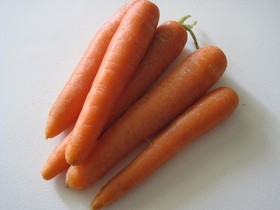What is it and what does it act against?
Beta-carotene is just one of more than 400 carotenoids which naturally occur in plants and fruits and give them their colour. The special thing about it, however, is that it is most common of all. Beta-carotene is the precursor to vitamin A, which is why it is often referred to as ‘provitamin A’. Theoretically, a beta-carotene molecule can be split into two vitamin A molecules; in practice, however, only part of the beta-carotene in the human body is converted to vitamin A.
The second surprising aspect is that beta-carotene is the most active of all carotenoids in terms of vitamin A effect. As insignificant as this may sound to a layperson at first, on closer examination, beta-carotene is surprising as it plays a key role in many important processes within our bodies. It plays an important role in reproduction, growth, cell metabolism and cell protection, immunity and even the regulation of the fat metabolism. We need it for healthy skin and for our eyes and hair, and our mucous membranes also rely on beta-carotene. Beta-carotene is a very important antioxidant (radical scavenger) and, in this capacity, is a very powerful protector of our cells; it has been shown to protect effectively against even serious diseases, such as cancer and cardiovascular disease.
It is not an exotic substance, or even a new one, but a natural one as old as the plants that contain it. Therefore, beta-carotene has been a significant health-giving companion of homo sapiens since time immemorial.
Unfortunately, beta-carotene has remained in the shadows over the years. As surprising as this may seem, science has only been interested in it for some 40 years, but has gained breath-taking insights, which this section will examine. We see its industrial use in the form of natural dyes to give certain foods, such as margarine, butter or fruit juices, an appetising colour and preserve them in a natural way (similar to how it ‘preserves’ the human body!).
Beta-carotene provides you with a natural substance that, as verified by studies, can reduce myocardial infarction by up to 50 %, protects against cancer and, as a radical scavenger, offers comprehensive protection against countless other illnesses and premature biological ageing.
Which foods contain beta-carotene and in what quantities?
The name ‘beta-carotene’ suggests an increased occurrence in carrots, but this is not exclusively so. One of the best sources of beta-carotene is spirulina, an algae that contains as much carotene in 10 g as there is in 156 g of carrots.
Where is beta-carotene most common? What are the best sources?
The best sources of beta-carotene are, in addition to the spirulina algae: yellow, orange and dark green vegetables and fruits.
Obtaining beta-carotene
To produce beta-carotene capsules, extractions from the same yellow, orange and green fruits and vegetables are used, such as carrots, peppers, tomatoes and more recently a microalgal species called ‘Dunaliella salina’, which has the highest carotene content of all known plant species.
For this purpose, the alga is subjected to increased light irradiation, a nitrogen
deficiency and at the same time a high salt concentration; under these conditions, it produces high levels of carotenoid droplets that provide the raw material for beta-carotene preparations.
Absorption and storage of beta-carotene in the body
Upon ingestion, only 10-50 % of the total amount of beta-carotene taken is absorbed in the gastrointestinal tract. The enzymes convert the beta-carotene into retinol (vitamin A) in the enterocytes of the intestinal mucosa. As the intake increases, the proportion of reabsorbed beta-carotene decreases. Here, the body regulates the conversion itself and once it has absorbed enough vitamin A, it slows down the conversion of beta-carotene into vitamin A. This makes the intake of beta-carotene safe and certainly does not lead to a feared vitamin A hypervitaminosis due to an excessive intake of beta-carotene. A large surplus is mainly stored in the fatty tissue and in the skin and the higher amount causes a yellowish skin colour. When the intake of beta-carotene decreases, this regulates itself again.
How does beta-carotene work and what does it act against?
Before turning to the real benefits of beta-carotene, we think it is of the utmost importance to first clarify the old debate about the possible side effects of beta-carotene in smokers, which continues to cause persistent and unfounded uncertainty among many consumers. This debate has unnecessarily resulted in more people associating beta-carotene with something dangerous than seeing it for what it is: a godsend for our health!
Does beta-carotene harm smokers?
Sadly, many people heard about beta-carotene for the first time, when, in the 1990s, the relevant media jumped at the chance to criticise it; namely stating that beta-carotene, which had made a name for itself in prophylaxis and even in the treatment of cancer, would, on the contrary, actually promote lung cancer in smokers!
What is true and how can the facts actually be evaluated?
In two studies conducted over several years in the 1990s, beta-carotene increased lung cancer risk rather than decreasing it, as had been hoped.
Summary of the effects of beta-carotene
- Beta-carotene binds the chain-breaking, aggressive peroxy radical as an antioxidant.
- Beta-carotene captures the singlet oxygen and neutralises it.
- Beta-carotene reliably protects against UV rays and the resulting cell damage, including skin cancer.
- Beta-carotene counteracts the destructive lipid peroxidation that causes us
- to age.
- Beta-carotene strengthens the immune system through the activation of T and B cells.
- Beta-carotene joins the group of key antioxidants and supports them in their work against damaging free radicals, which are considered to be the main trigger for most diseases and biological ageing.
- Beta-carotene regulates lipid metabolism – a fact that should be of particular interest to overweight people.
Foto ©Wilhelmine Wulff by pixelio.de



